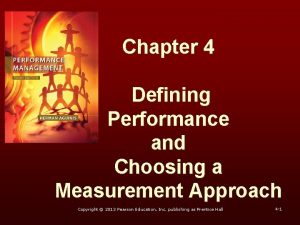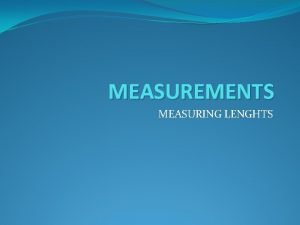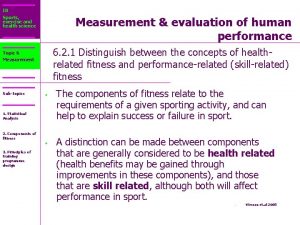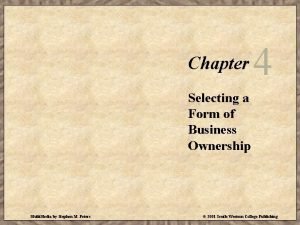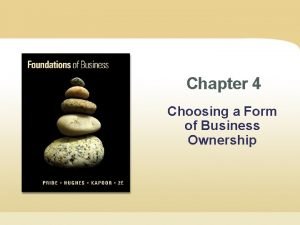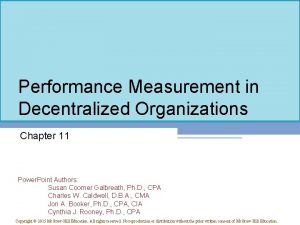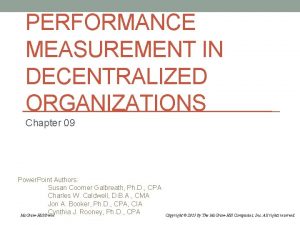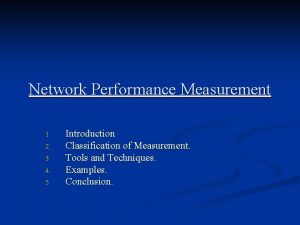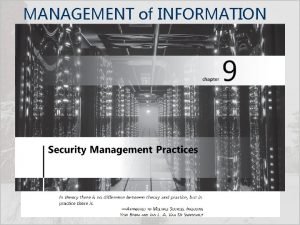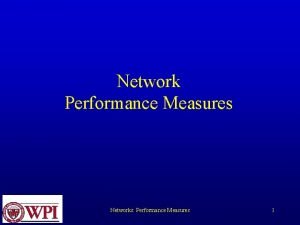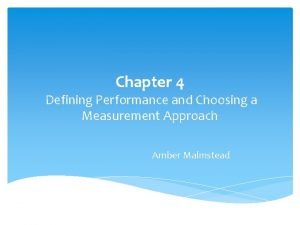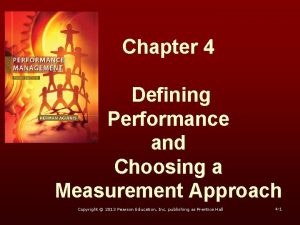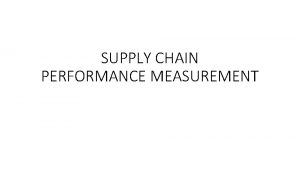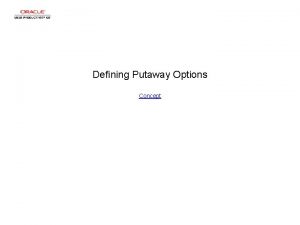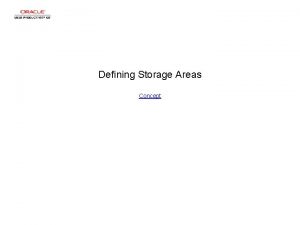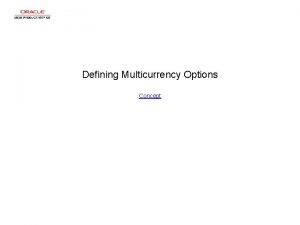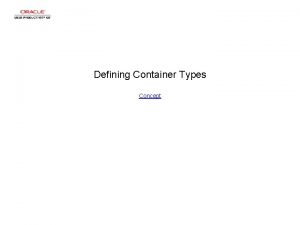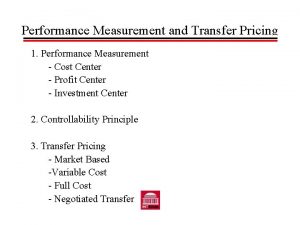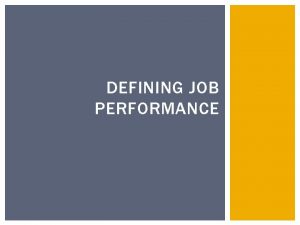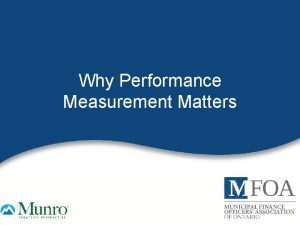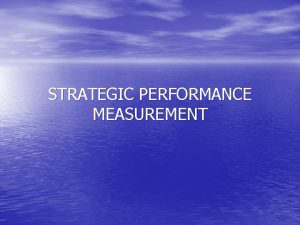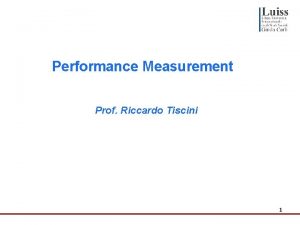Chapter 4 Defining Performance and Choosing a Measurement

























- Slides: 25

Chapter 4 Defining Performance and Choosing a Measurement Approach Copyright © 2013 Pearson Education, Inc. publishing as Prentice Hall 4 -1

Defining Performance is defined as what an employee does (his or her behaviors). It does not include the results or outcomes of an employee’s behaviors. Copyright © 2013 Pearson Education, Inc. publishing as Prentice Hall 4 -2

Two Additional Characteristics of the Behaviors Labelled Performance 1. Evaluative – such behaviors can be judged as negative, neutral, or positive for individual and organizational effectiveness. Thus, the value of these behaviors can vary based on their contribution toward the accomplishment of individual, unit, and organizational goals. 2. Multidimensional – There are many different kinds of behaviors that can advance (or hinder) organizational goals. Copyright © 2013 Pearson Education, Inc. publishing as Prentice Hall 4 -3

Behaviors are Not Always Observable or Measurable Because not all behaviors are observable or measurable, PM systems often include measures of results or consequences that we infer are the direct result of employees’ behaviors. Copyright © 2013 Pearson Education, Inc. publishing as Prentice Hall 4 -4

Results or Consequences May Be Used to Infer Behavior A salesperson whose job consists of visiting clients to offer them products or services is often evaluated on his or her sales volume – a proxy for a behavioral measure – since the salesperson’s supervisor may be back in the home office and cannot observe the salesperson’s behaviors. Copyright © 2013 Pearson Education, Inc. publishing as Prentice Hall 4 -5

Determinants of Performance = Declarative Knowledge X Procedural Knowledge X Motivation Copyright © 2013 Pearson Education, Inc. publishing as Prentice Hall 4 -6

Declarative Knowledge is information about: • Facts and Things (including information regarding a given task’s requirements) • Labels • Principles • Goals Copyright © 2013 Pearson Education, Inc. publishing as Prentice Hall 4 -7

Procedural Knowledge is a combination of: n n Knowing what to do and how to do it. Includes cognitive, physical, perceptual, motor, and interpersonal skills. Copyright © 2013 Pearson Education, Inc. publishing as Prentice Hall 4 -8

Motivation involves three types of choice behaviors: • Expenditure of effort (e. g. , “I will go to work today. ”) • Level of effort (e. g. , “I will put in my best effort at work today. ”) • Persistence of effort (e. g. , “I will persist no matter what. ”) Copyright © 2013 Pearson Education, Inc. publishing as Prentice Hall 4 -9

Deliberate Practice involves the following steps: n Approach performance with the goal of getting better and better. n As you are performing, focus on what is happening and why you are doing things the way you do. n When your task is finished, seek performance feedback from many expert sources. n Build mental models of your job, your situation, and your organization. n Repeat steps 1 -4 on an ongoing basis. Copyright © 2013 Pearson Education, Inc. publishing as Prentice Hall 4 -10

Implications for Addressing Performance Problems In order to address performance problems properly, managers must find information that will allow them to understand whether the source of the problem is declarative knowledge, procedural knowledge, motivation, or some combination of these factors. Thus, PM systems need not only measure performance but also provide information about the source of any performance deficiencies. Copyright © 2013 Pearson Education, Inc. publishing as Prentice Hall 4 -11

Factors Influencing Determinants of Performance n n Three individual characteristics procedural knowledge, declarative knowledge, and motivation – determine performance. In addition, HR practices (e. g. , the amount of training available to employees) and the work environment (e. g. , downsizing) can affect performance. Copyright © 2013 Pearson Education, Inc. publishing as Prentice Hall 4 -12

Performance Dimensions: Types of Multidimensional Behaviors Since performance is multidimensional, we need to consider many different types of behaviors to understand it. Two types of behaviors are particularly important: n n Task performance. Contextual performance (also called prosocial behaviors or organizational citizenship behaviors). Copyright © 2013 Pearson Education, Inc. publishing as Prentice Hall 4 -13

Task Performance is defined as activities that: n n transform raw materials into the goods and services that are produced by the organization. help with the transformation process by replenishing the supply of raw materials; distributing its finished products; or providing important planning, coordination, supervising, or staff functions that enable the organization to function effectively and efficiently. Copyright © 2013 Pearson Education, Inc. publishing as Prentice Hall 4 -14

Contextual Performance is defined as behaviors that contribute to an organization’s effectiveness by providing a good environment in which task performance can occur. Contextual Performance includes behaviors such as: n Persisting with enthusiasm and exerting extra effort as necessary to complete one’s own task activities successfully. n Helping and cooperating with other coworkers. n Following organizational rules and procedures. Copyright © 2013 Pearson Education, Inc. publishing as Prentice Hall 4 -15

Differences Between Task and Contextual Performance n Task Performance • Varies across jobs • Likely to be role prescribed • Influenced by Abilities and Skills n Contextual Performance • Fairly similar across jobs • Not likely to be role prescribed • Influenced by Personality Copyright © 2013 Pearson Education, Inc. publishing as Prentice Hall 4 -16

Why Include Task and Contextual Performance Dimensions in a PM System? 1. 2. 3. Global competition is raising the level of task and contextual performance required of employees for an organization to be competitive. Customer service – Global competition is also raising the need for outstanding customer service. Teamwork – Many organizations have formed employees into teams. Copyright © 2013 Pearson Education, Inc. publishing as Prentice Hall 4 -17

Why Include Task and Contextual Performance Dimensions in a PM System? (continued) 4. Employee perceptions of PM – Employees are more satisfied with the PM system and believe it is fairer if contextual performance is measured in addition to task performance. 5. Supervisor views – Since contextual performance has an impact on ratings of overall performance even when only task performance is measured, it makes sense to include contextual performance more explicitly. Copyright © 2013 Pearson Education, Inc. publishing as Prentice Hall 4 -18

Voice Behavior that emphasizes expression of constructive challenges with the goal of improving employee performance rather than merely criticizing it. Challenges the status quo in a positive way. Makes innovative suggestions for change. Recommends modifications to standard procedures. Copyright © 2013 Pearson Education, Inc. publishing as Prentice Hall 4 -19

Job Performance in Context A performer (individual or team with TRAIT certain traits) In a given work situation Engages in certain behavior s That produce various results BEHAVIOR RESULTS Copyright © 2013 Pearson Education, Inc. publishing as Prentice Hall 4 -20

Job Performance in Context The previous power point shows that employees do not perform in a vacuum. Instead, they work in an organizational context, engaging in certain behaviors that produce certain results. The same employees may behave differently (and produce different results) if placed in a different situation (e. g. , working with a different supervisor or using better machinery). Copyright © 2013 Pearson Education, Inc. publishing as Prentice Hall 4 -21

Approaches to Measuring Performance Behavior Approach n Emphasizes how employees do the job. Does not consider employees’ traits or the outcomes resulting from their behaviors. Results Approach n Emphasizes only the outcomes produced by employees. Trait Approach n Emphasizes only the individual traits (e. g. , intelligence, conscientiousness) of employees. Copyright © 2013 Pearson Education, Inc. publishing as Prentice Hall 4 -22

Behavior Approach Appropriate if: n Employees take a long time to achieve desired outcomes. n Link between behaviors and results is not obvious. n Outcomes occur in the distant future. n Poor results are due to causes beyond the performer’s control. Not appropriate if: n The above conditions are not present. Copyright © 2013 Pearson Education, Inc. publishing as Prentice Hall 4 -23

Results Approach Advantages: • Takes less time and is less expensive than tracking employees’ behavior. • Data appear objective. Most appropriate when: • Workers skilled in necessary behaviors. • Behaviors and results obviously related. • Consistent improvement in results over time. • Many ways to do the job right. Copyright © 2013 Pearson Education, Inc. publishing as Prentice Hall 4 -24

Trait Approach Most appropriate when: n Emphasis on individual • Evaluate stable traits (i. e. , cognitive abilities, personality) n n Positive relationship between abilities, personality traits, and desirable work-related behaviors Appropriate if structural changes planned for organization Disadvantages n Improvement of traits is not under individual’s control n Trait may not lead to desired behaviors or results Copyright © 2013 Pearson Education, Inc. publishing as Prentice Hall 4 -25
 Defining performance and choosing a measurement approach
Defining performance and choosing a measurement approach Approaches to measuring performance
Approaches to measuring performance Defining and non defining relative clauses
Defining and non defining relative clauses Relative clauses defining and non defining
Relative clauses defining and non defining Non defining relative clauses as sentence modifiers
Non defining relative clauses as sentence modifiers Defining and non defining relative clauses in telugu
Defining and non defining relative clauses in telugu Non essential adjective clause
Non essential adjective clause Where kullanımı relative clauses
Where kullanımı relative clauses Choosing appropriate metric units of measurement
Choosing appropriate metric units of measurement Progress and performance measurement and evaluation
Progress and performance measurement and evaluation Progress and performance measurement and evaluation
Progress and performance measurement and evaluation Measurement and evaluation in human performance 5e download
Measurement and evaluation in human performance 5e download Vertical jump
Vertical jump Chapter 1 choosing your career
Chapter 1 choosing your career Business ownership
Business ownership A corporation organized to provide a social educational
A corporation organized to provide a social educational Chapter 21 lesson 2 choosing to live alcohol free
Chapter 21 lesson 2 choosing to live alcohol free Chapter 20 tobacco vocabulary practice
Chapter 20 tobacco vocabulary practice Performance measurement in decentralized organizations
Performance measurement in decentralized organizations Performance measurement in decentralized organizations
Performance measurement in decentralized organizations Network performance measurement tools
Network performance measurement tools Nist 800-55
Nist 800-55 Comparative performance measurement system
Comparative performance measurement system Network performance measurement tools
Network performance measurement tools Quantum performance measurement
Quantum performance measurement Network performance measurement
Network performance measurement

